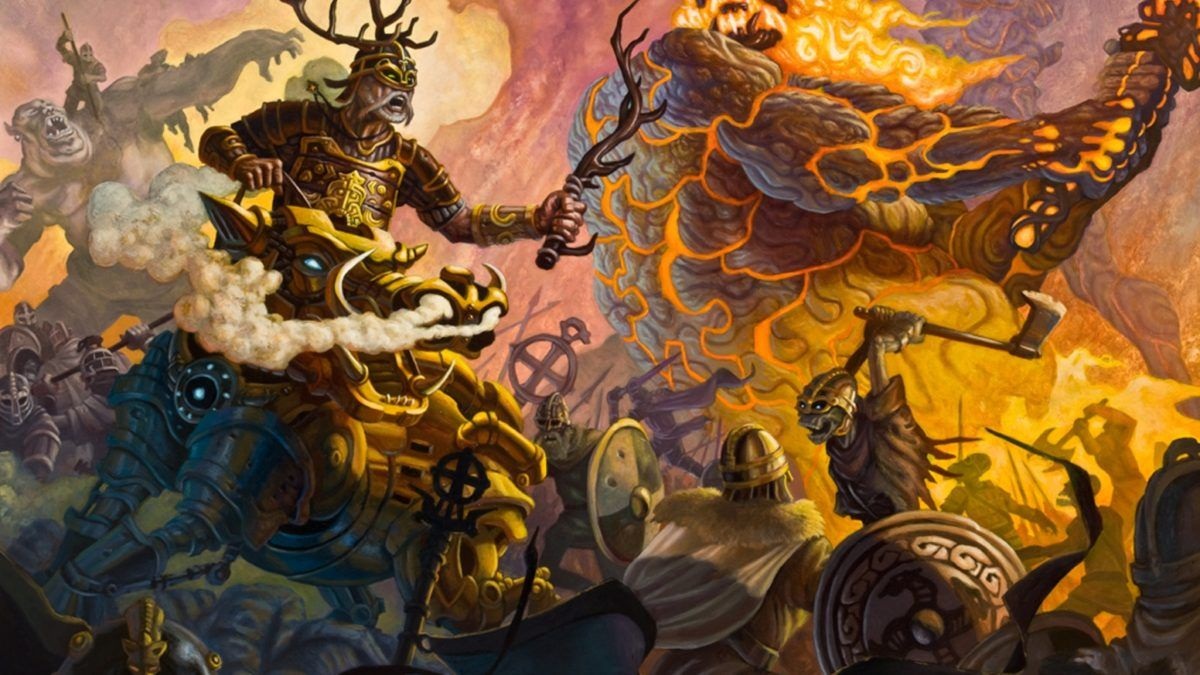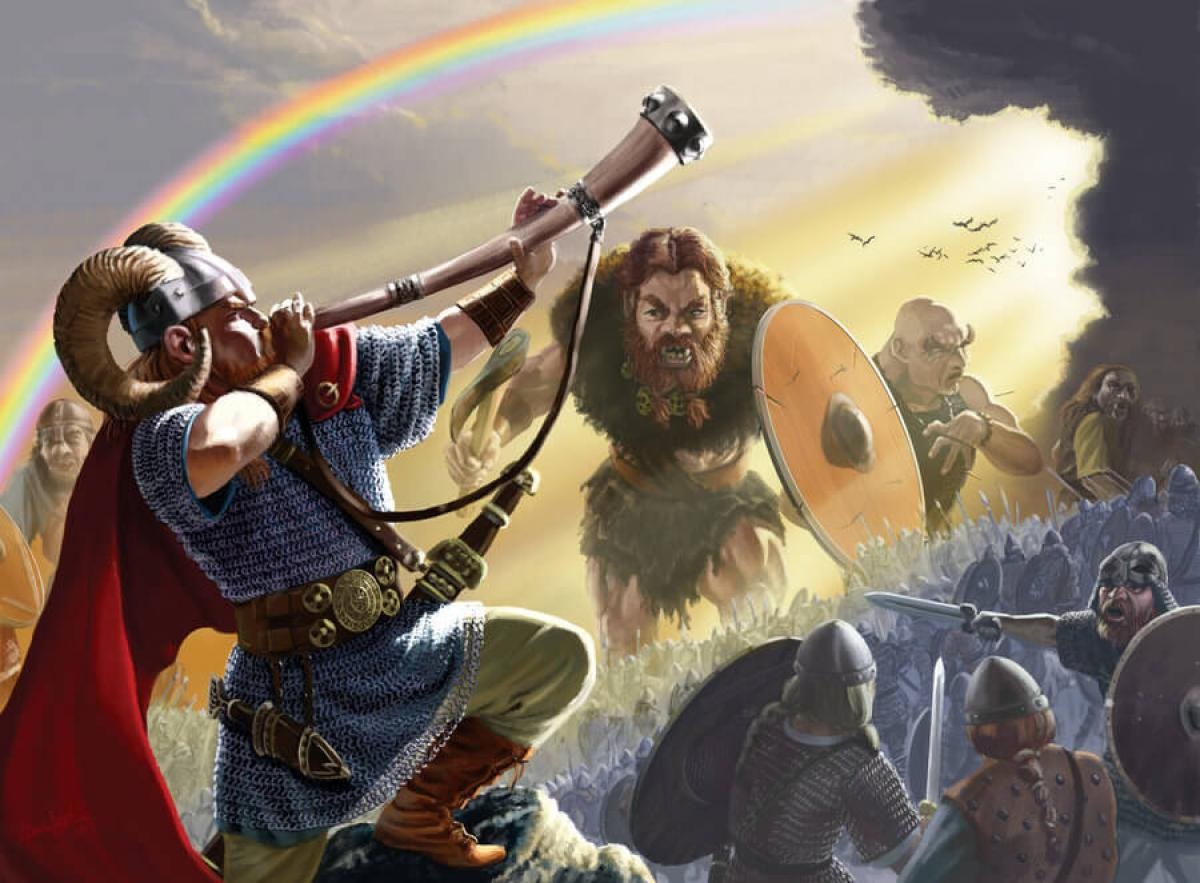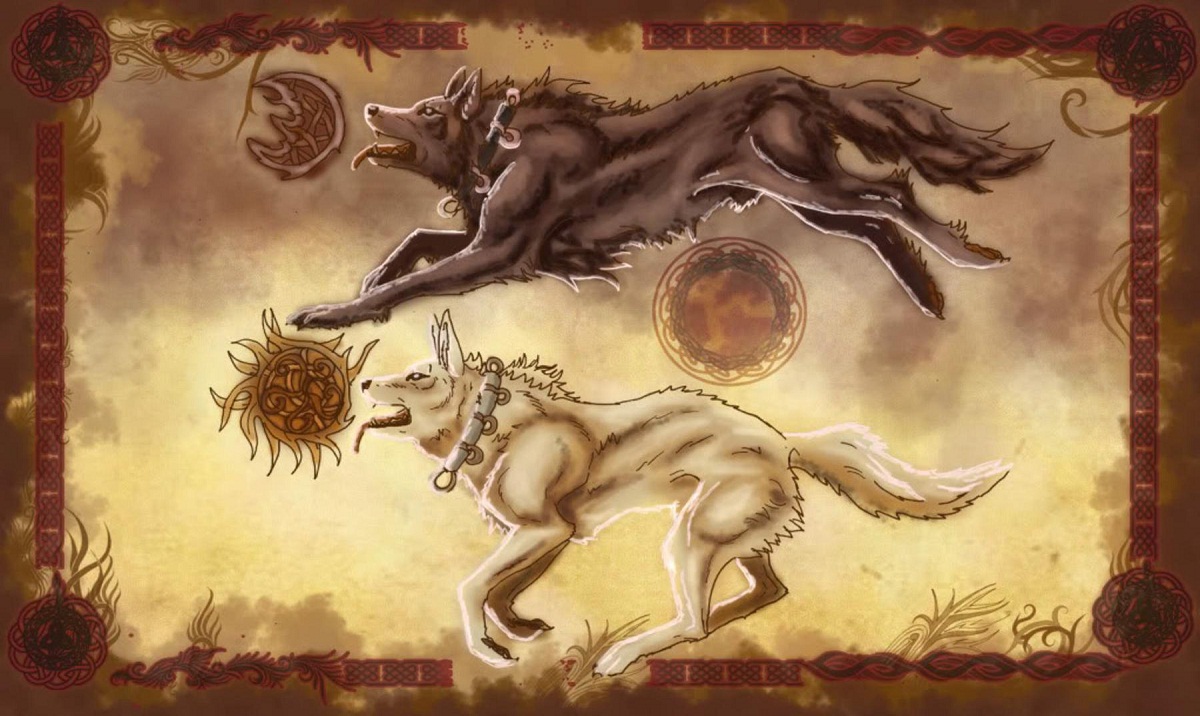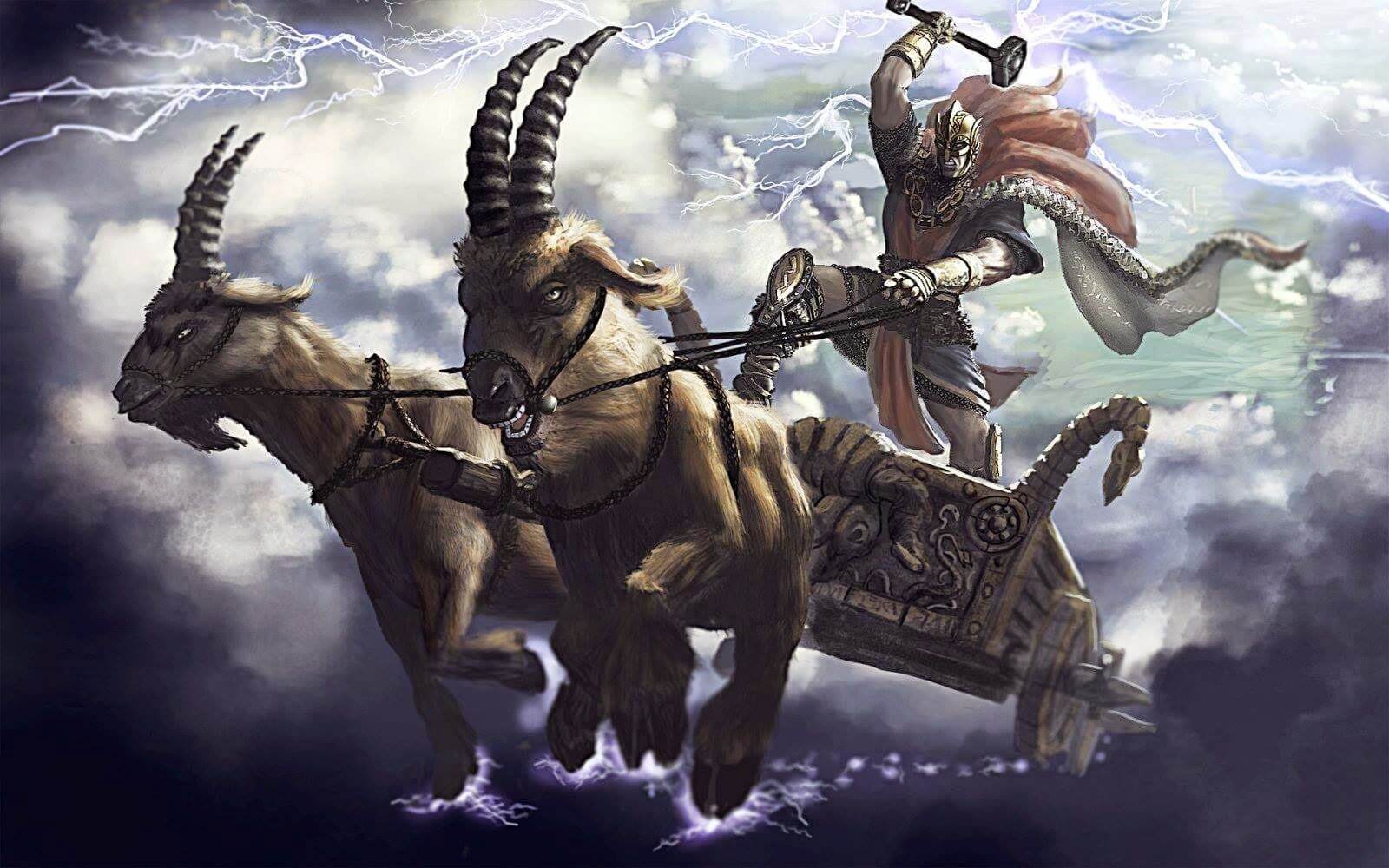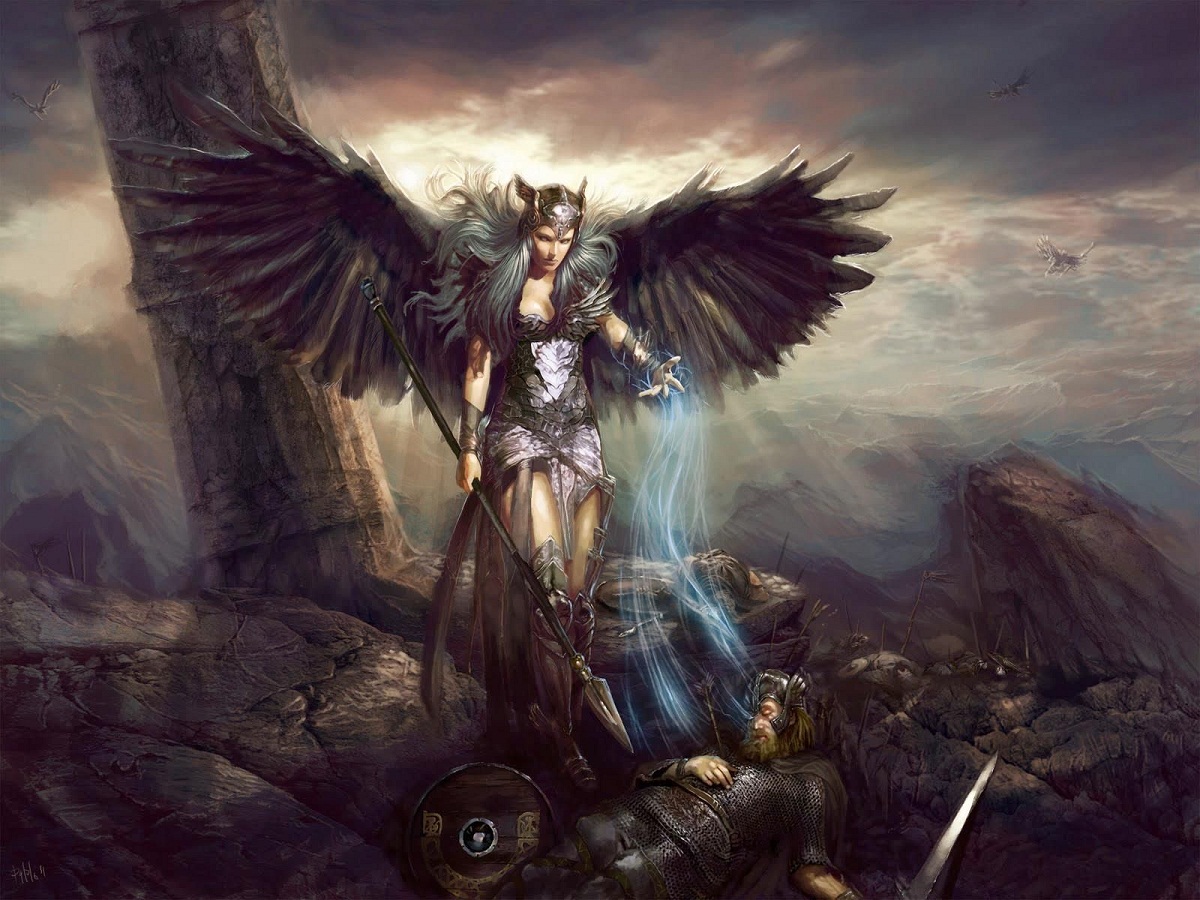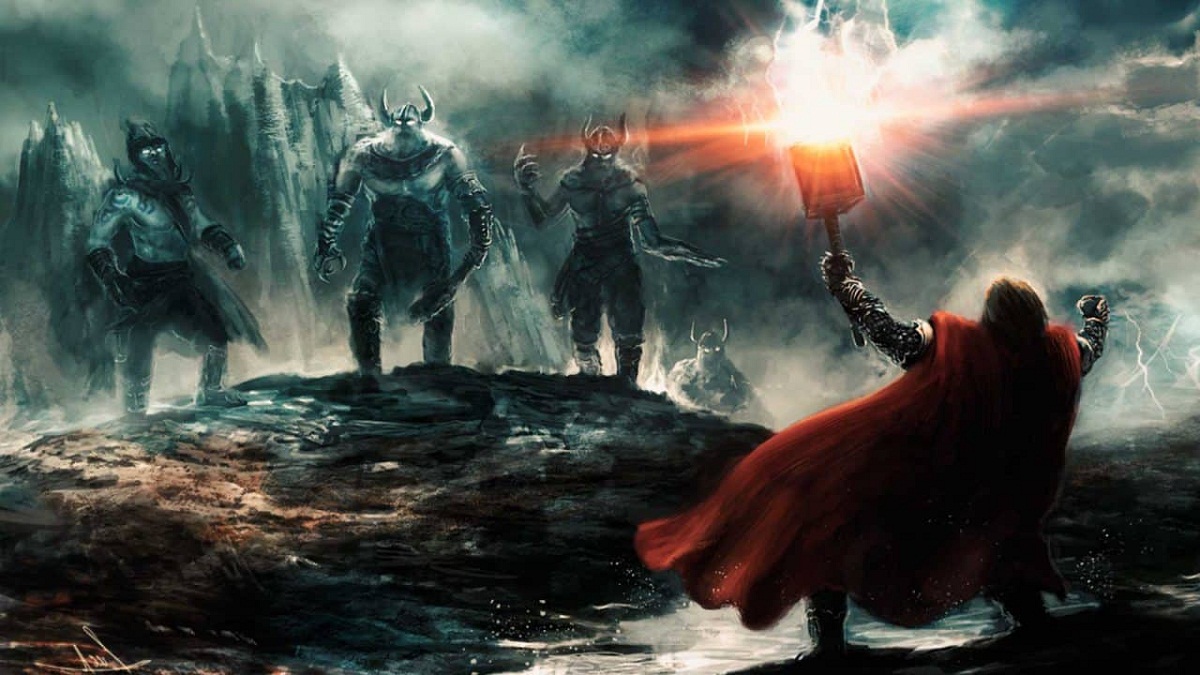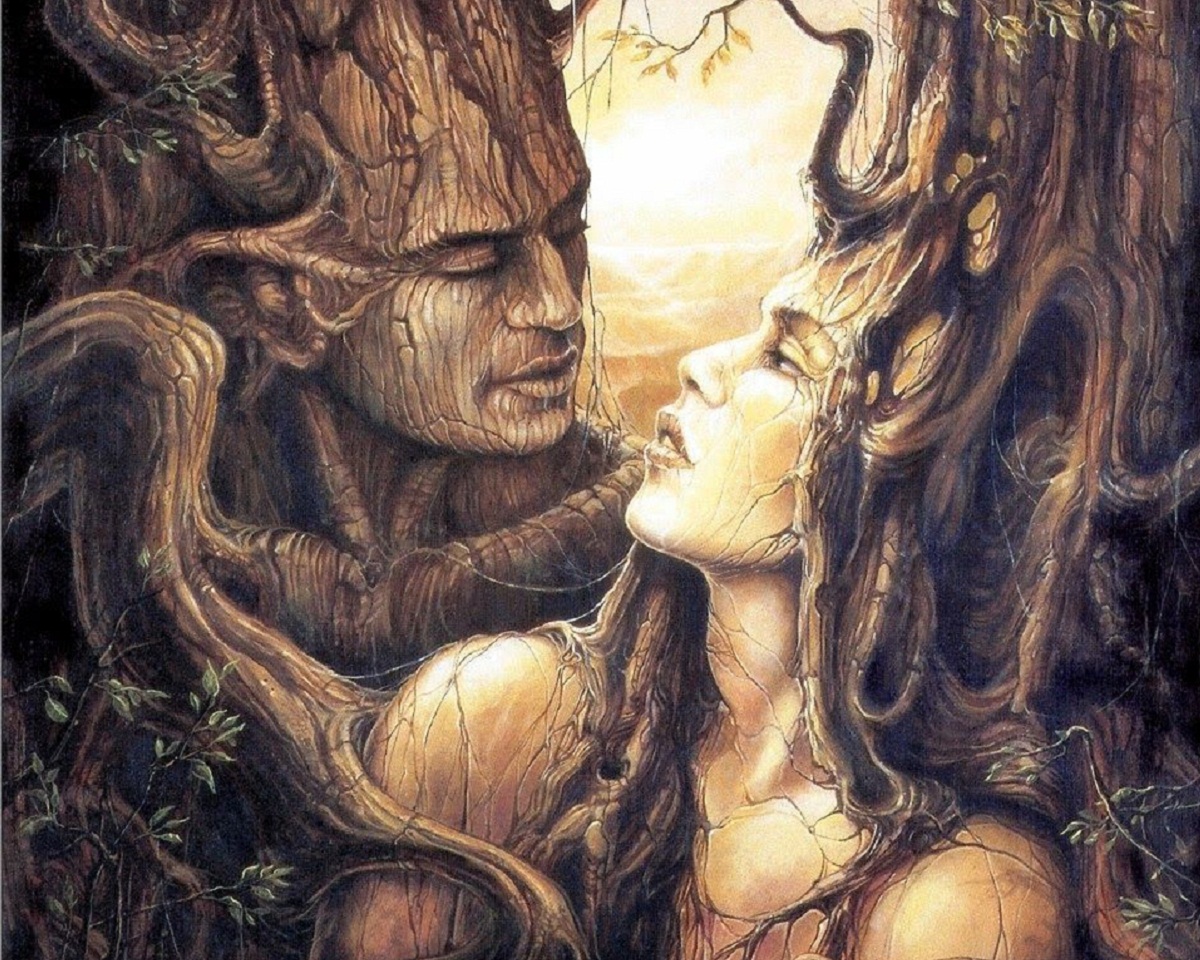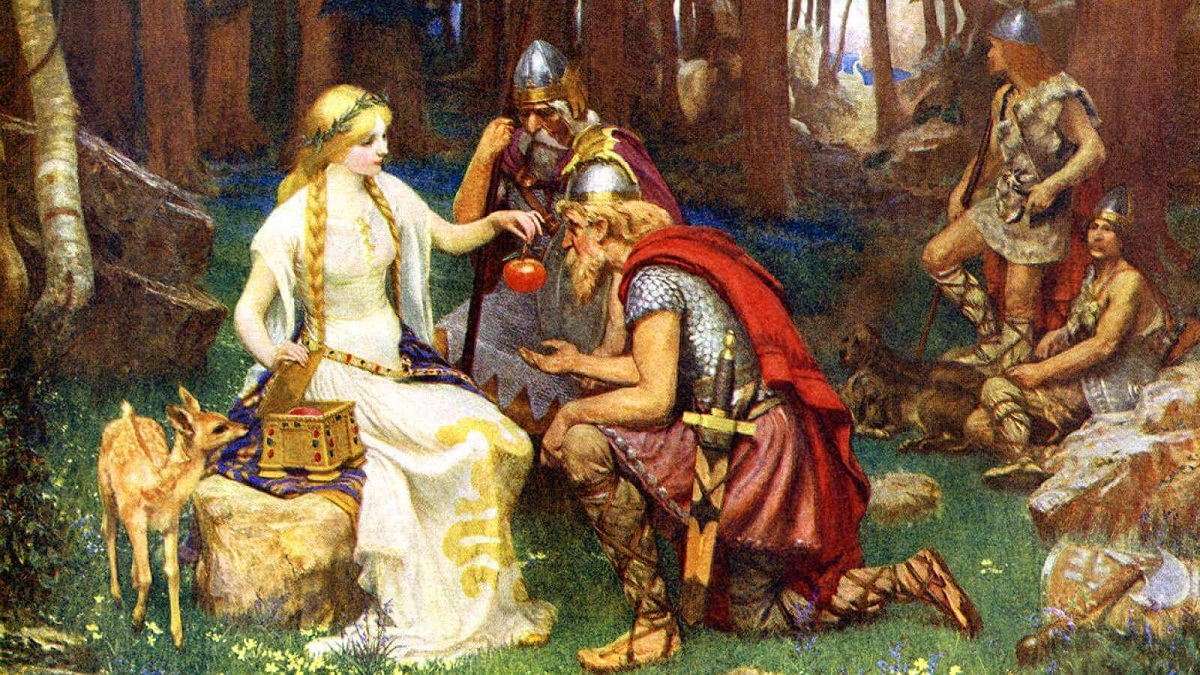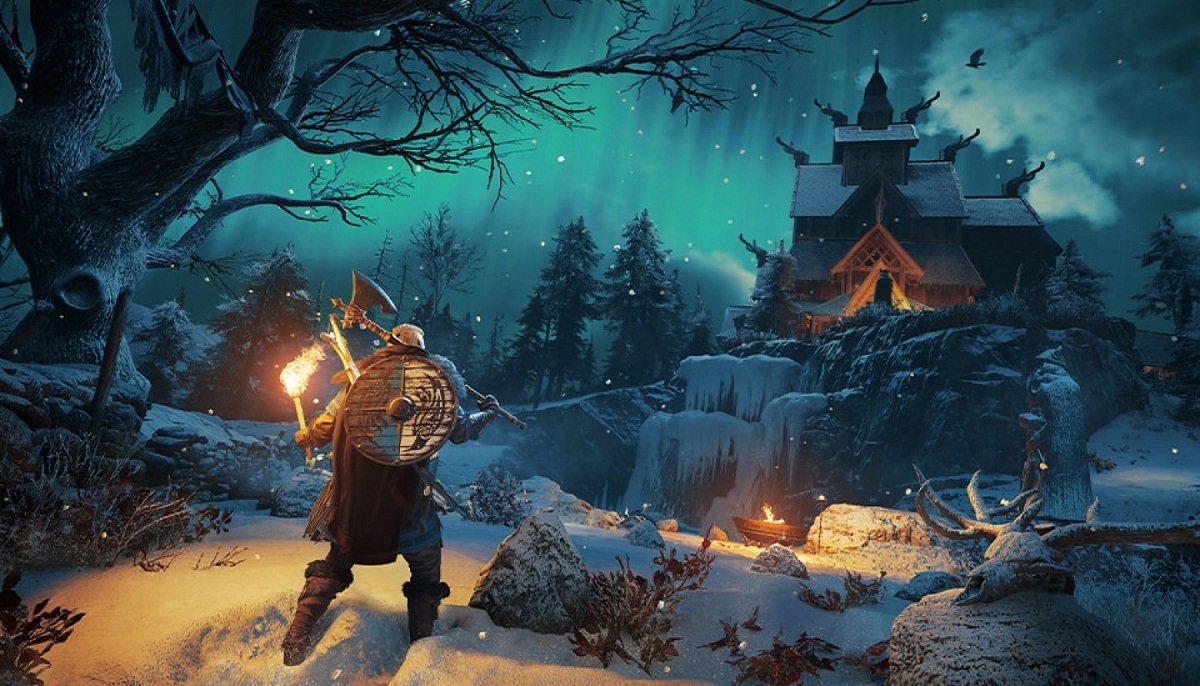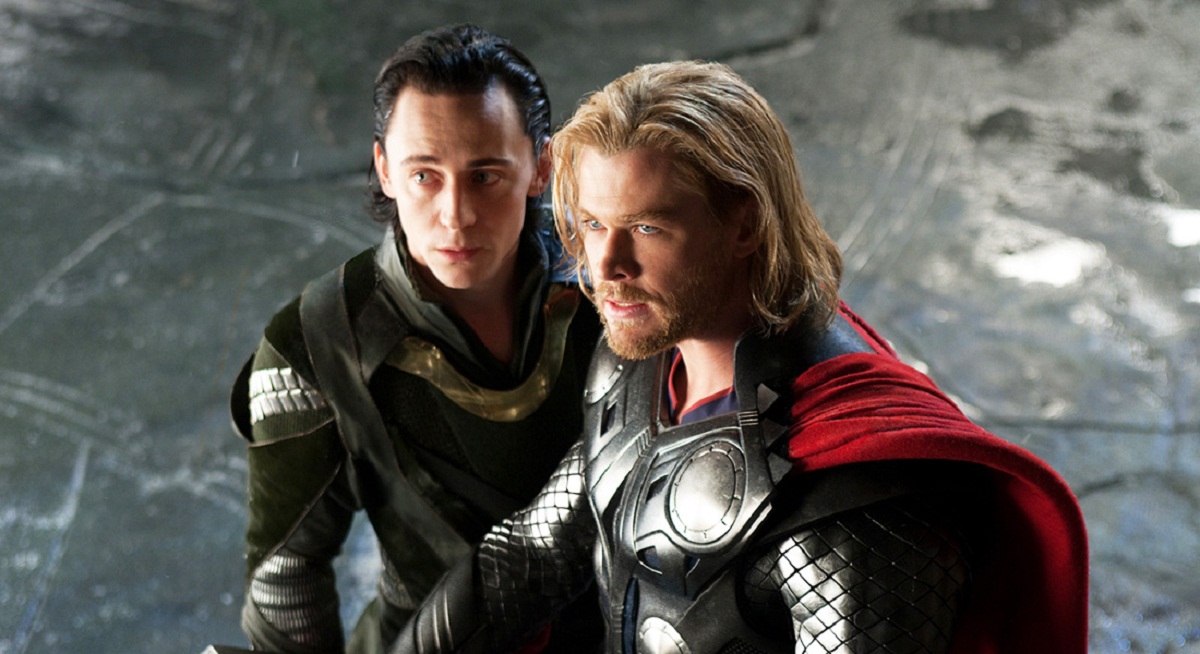In order to learn a little more about the Nordic myths best known of these supernatural beings, who took their powers through the consumption of Iðunn's apples, achieving their feats, we invite you to visit this interesting post. Don't stop reading it!
What are the Norse myths?
It is important to clarify that these myths include the beliefs, religion and legends of the Germanic peoples, specifically the Scandinavians, so you can hear or read terms referring to Germanic or Scandinavian and correspond to these interesting Nordic myths.
In addition, these Norse myths come from Indo-European mythology, which was a transmission of oral culture. Later, thanks to the settlements that were made in the cities of Brittany, Iceland, Hispania and Gaul, it was possible to gather the information sources in writing with the intention of preserving them.
In the Nordic myths, the beliefs and legends shared by these peoples who were located in the northern space are preserved, since the other Nordic peoples did not share these myths, as is the case with the Uralic ethnic group.
Made up of the Lapps, Estonians and Finns, much less the Baltic ethnic group that was made up of Lithuanians and Latvians since they had their own legends, although somewhat similar.
As for the Nordic myths, there was no religion given by the deities to the people, but in the legends mortals are told that they were visited by the gods, there was not even a sacred book as in other cultures, since its transmission was oral through poetry that was long.
In relation to the Nordic myths, they were transmitted from generation to generation even in the time that dates back to the Vikings and their existence is known.
Thanks to the Eddas that were the compilations related to these interesting legends as well as other texts from the medieval era that were written during Christianization.
So these Nordic myths are part of the Scandinavian culture and today it can be seen that they maintain some traditions that date back to that ancient time while others have been taken up again thanks to Germanic neopaganism that tries to reconstruct the ancient religion of these peoples .
Likewise, the Nordic myths are evidenced in a diversity of literature and in audiovisual films, drawing the attention of viewers with legends that are part of the Nordic myths and through this article you will learn about each of them, so we invite you to continue reading.
Regarding the creation of the Cosmos
According to Norse myths, the world is symbolized by a flat disc and is located in the branches of a huge tree known as Yggdrasil, which is responsible for sustaining the number of nine worlds and amazing creatures inhabited each world.
At the roots of this immersed tree was, according to the Norse myths, a dragon known by the name of Nidhogg who was in charge of gnawing the roots of that immense tree in order to reach an eagle that gets its name from it Ragnarök and was located in the highest part of said tree.
This huge eagle was in charge of watching over the nine worlds and in the Norse myths it is said that this majestic bird had a falcon that was located between its eyebrows and is called Veörfölnir, which is in charge of observing all the movements of the eagle.
Another of the animals found in Nordic myths is a squirrel named Ratatösk that is in charge of running from the roots to the top of the immense tree, this little animal is in charge of sowing discord between the dragon and the eagle through false news .
There is a world with the name of Asgard, which is the highest region of the sky where the deities lived and was located in the center of the flat disk. In order to reach this world, it was necessary to travel through the rainbow, which was a kind of bridge known as Bifrost.
This path was guarded by Heimdall who was the son of Odin and had excellent hearing in addition to his enormous vision, for which he was the one to warn with his enormous horn when any deity crossed the rainbow. As for the giants according to these Norse myths they were located in Jötunheim.
There was another world that was cold and dark that received the name of Niflheim and within this space there was a place called Helheim that was ruled by Hela the daughter of Loki according to the Norse myths specifically the Prose Edda in this place the dead remained.
It was located south of the hot kingdom of Muspelheim which was home to the huge fire giants, Surt being the most powerful of them and their leader.
Another of the kingdoms that was part of this cosmos was Alfheim, which was the residence of the elves of light known as ljósálfar and they were elves of unparalleled beauty. Instead there was another world for the dark elves known as Svartálfaheim according to Norse myths these last elves were not beautiful and used dark magic.
Between the worlds of Asgard and Niflheim was another world that was known by the name of Midgard, this space was the lower region of the sky and was inhabited by mortal beings, that is, humans. The importance of the dual principle can be evidenced in the Nordic myths, so the Sun was a goddess called Sól.
He was in charge of going through the dawn on a horse drawn horse while Sköll was the representation of the darkness where the moon was and was a wolf that chased the goddess Sól to devour her.
This wolf was called Hati and Máni was the name of the moon in Norse myths, so according to legend every time Hati was close to the goddess Máni to devour her, lunar eclipses occurred in the sky.
Likewise, the duality of the Norse myths is observed in these two worlds: Niflheim, which was a dark and cold world where the dragon lived, and Muspelheim, which was a place full of fire, home of the fire giants.
Allowing the other worlds to originate, for which the metaphysical thought of duality is observed in order to be able to create the cosmos through the legends exposed in the Norse myths.
Supernatural Beings in Norse Myths
Odin was the god with the highest hierarchy and the father of all according to the Norse myths as for the other gods there were three divisions called AEsir, Vanir that belonged to natural elements and Jotum that were the giants.
Therefore, according to their myths, the peoples of this Nordic culture worshiped two clans of gods, the first of which was AEsir, who were the male gods and the female goddesses identified with the term Asynjur. These deities were in charge of integrating the assembly and it is chaired by the powerful Odin.
According to the Nordic myths, among these deities was Thor, who symbolized Thunder, used iron gloves and his hammer named Mjolnir, he also had a magical belt, he was the god of strength, he was close to Odin in terms of rank.
Balder followed him, another son of Odin represented beauty and intelligence, Tyr was the god of courage, he was the deity who sacrificed his hand so that the other gods could tie the gigantic wolf named Fenrir. Bragi was the god of wisdom and eloquence. Heimdall was the son of nine maidens and Odin.
This deity is the guardian of the other gods because he sleeps very little and blowing the huge horn can be heard from anywhere on earth or in the sky.
Höör was a blind deity who killed his brother Balder with a dart from a plant called mistletoe, which was the only plant that could hurt him.
Well, the mother wife of Odin at birth Balder made all living or inert beings promise not to harm her beloved son but she forgot a small plant that was the mistletoe.
So Loki, who was fed up with Balder's ego and invulnerability, gave Höör a dart made from this plant and helped him by throwing it at the deity who was blind, touched his brother and killed him.
Then Loki was punished by Odin for which he tied him to three huge stones and ordered a snake to spit venom on Loki's face from time to time, which caused him terrible pain in addition to deforming his face.
Another deity was Vidar, who was a taciturn god, he was in charge of resolving any conflict, he had that ability as the Norse myths comment. Váli was the god who represented archers and his aim was unbeatable. Ull was the deity who represented close combat.
Forseti is the god of harmony and friendship. As for Loki, he was the god of chaos, he brought with him the misfortune and misfortune of all the AEsir, even for humanity, he was a cunning and warping deity as well as being unpredictable, fickle, very given to lies and tricks.
As for the female deities according to the Norse myths, there was Frigg who was a seer as well as being the wife of the magnanimous Odin, Eir who was the healer, the goddess Siöfn who carried the thoughts of men towards the feeling of love. Var was the deity who represented the oaths.
The goddess Syn according to Norse myths was the guardian of the gates, Iðunn was the goddess who kept the apples that could make the deities young again, there the great power of each God was the wife of Bragi.
The second class of gods The Vanir
According to the Norse myths, the first deities of the sky were the Aesir, but according to their culture they also worshiped other deities that came from the sea, the forests, the wind, and the forces that nature emits. These deities were known by the word Vanir and they resided in Vanaheim.
These deities, according to the Norse myths, ruled their domains, so Njörör was in charge of dominating the wind and the sea as well as fire, his wife was Skaöj, who was a hunting deity.
Frey who was in charge of the rain and the sun. He was invoked by the people to achieve excellent harvests since he represented fertility. Frevja was the goddess of love and both were her children.
The interaction between the deities AEsir and Vanir
In this interaction, the dual principle of the Nordic myths is present, since the first deities represented by the AEsir were warriors while the second deities that were symbolized by the Vanir were peaceful and it is evident in their legends that there were deities that belonged to both sides. .
Therefore, according to these Norse myths, Frey and Frevja were two faces of the same deity that later separated and the reputation of the goddess Frevja and the similarity of their names and functions made them resemble the goddess Frigg, wife of Odin.
According to research carried out by Georges Dumézil, a difference is observed in the actions of the Vanir, since they were in charge of sowing, harvesting and the climate, while the AEsir were in charge of spiritual matters and a peace pact prevails between them.
In addition to the exchange of hostages and weddings that took place after an extensive confrontation between these deities and the battle was won by the AEsir, that is why Njörd had to move to Asgard to live with his wife and two children.
And in the abode of the Vanir, Odin's brother called Hoenir forged his residence, according to these Norse myths, an impersonation of the deities corresponding to nature is performed.
Others comment that according to Indo-European legends, a similarity is made to Greek history in terms of the fight between the deities of Olympus and the Titans or even the Hindu confrontation with the Mahabharata.
The Jotuns or the Giants
They were dangerous for mortals because the Jotuns had supernatural forces they resemble the titans of Greek mythology but in the Norse myths they were also compared to trolls or demons they were very ugly but they had great wisdom in addition to possessing wealth the other deities benefited from they.
Among them stands out in the Nordic myths the creation of the cosmos from the body of Ymir who was the first of these giants and the unparalleled beauty of the giant Gerör who was the wife of the god Freyr, it is said that this beautiful woman would be the representation of fertility since Freyr was the god of fertility.
Relations between the deities and the Jotuns
As evidenced through the Norse myths some of the AEsir deities were descendants of the Jotuns as nuptial agreements were made between them.
Which is evidenced in the Eddas and are symbols of nature, it is essential to note that the giants were divided into two clans, those of fire and those of ice, maintaining a hostile confrontation with the deities.
They become real in the Nordic myths through the warlike confrontations that Thor led and in the future battle of Ragnarök the forces that will be in charge of the destruction will be under the orders of the giants Surt who was the leader of the giants of fire and Hrym was the captain of a great ship.
Other beings of great renown in Norse myths
Below we will describe some of the most representative beings of other Norse myths:
Norns
Also known by the word nornir according to the Nordic myths, they were in charge of dictating destiny and they were irrevocable and it is said that they were numerous in history, more in the time that dates back to the Scandinavians, three norns of great importance are evidenced, the which reside in the roots of Yggdrasill.
Being Urör who represents what has happened, Veröandi the present and what is currently happening and Skuld referring to the future what is going to happen, they were in charge of spinning the destiny of men through tapestries and as for the heroes used threads of gold to forge your destiny.
These spinners were related according to Norse myths with the dísir who were female figures associated with the death of people and the Valkyries which were under the command of the magnanimous Odin and they were related to destiny which was of great importance for the culture. nordic
Valkyries
These prominent female characters play a large role in Norse myths and were selected by Odin himself. These female figures, in addition to being beautiful, were strong warriors with healing skills.
The work of these beautiful women was to take to Valhalla the heroes who had fallen in the war who were selected by Odin in that place they attended them and gave them mead to drink in addition to enthralling men with their great beauty according to the norse myths
According to Norse myths, the Valkyries were virgin beings and resided in Vingólf, which was next to Valhalla, although they were selected by Odin himself, they were under the orders of the goddess Freyja.
The Dwarfs and Elves
One of the special races in the Norse myths were the dwarfs, as they are said to have been worms that had transformed into small people when they came out of Ymir's flesh. The giant who was killed by the gods at the beginning of time according to the Norse legend.
These supernatural beings live underground in the world known as Svartalfheim and one of their main functions is mining in addition to metallurgy. They are very wise so they can forge weapons with magical feats for the heroes as well as powerful objects for the deities, including Thor's hammer.
As for the elves according to the Scandinavian era, the alphas of light known as liosalfar were divided into two clans, which resided in the sky in the residence of Frey, this world is called Alfheim.
The second clan was known as the dark álfar and they identified themselves with the following word svartálfar and dökkálfar. These second elves were actually a variant of the dwarfs according to Norse myths as it was a mix between elves and dwarves.
Well, according to the Nordic myths, the elves were cataloged as slender and majestic figures, but through the Nordic tradition they were lowered down the ladder until they became tremendous beings of short stature.
For which they are evidenced in the literature of William Shakespeare and the relationship of these beings with men is dual like everything in the Norse myths since they are capable of bringing wealth as well as being a promoter of diseases and misfortunes at the end of the autumn season. made offerings of great importance.
Creatures or Beasts
They are other supernatural beings that attract attention in Norse myths and among them the main one is the gigantic wolf named Fenrir as well as the sea serpent that surrounds the world named Jörmungandr.
Both mythological creatures are children of the god Loki and the giant Angrboda who was a great sorceress without forgetting Hela, the ruler of the underworld in Norse culture.
There are other creatures that are indulgent, such as Hugin and Munin, who were two ravens that were in charge of collecting news in the worlds and transmitting them to Odin with thought and memory in Norse myths.
In addition to Ratatösk, the squirrel that is in charge of ascending and descending the immense tree that is the main entity of the universe. It is a beautiful tree named Yggdrasil, it is the tree of life or ash tree of the Universe. It is said in Norse myths that Odin hung from its branches for nine days and with it came to visualize the runes.
Another of the beasts or creatures of the Norse myths is the eight-legged horse that Odin used and was the son of Loki when he became a mare and became pregnant by a horse that was owned by a great giant because it is said that the god of chaos and mess was a hermaphrodite.
Similarity to other mythologies
As far as the Norse myths are concerned, they lack the confrontation between good and evil of the cultures that are observed in the Middle East. For the deities possessed extensive powers recognized as a region.
Therefore, the god Loki is not only the adversary of the Norse deities, as is the case with Thor, and the giants are not bad, but rather temperamental and uncivilized according to Norse myths, and the structure of their foundation is order against chaos.
The Nordic deities are at all times the order and Loki together with the giants and the monsters or supernatural creatures represent the chaos and the disorder in these legends of the Nordic myths.
The Origin and End of the World: Völuspá
They are described according to Norse myths in a work known as Völuspá which translates as the Prophecy of Völva or Sibyl and is one of the best known poems in the Poetic Edda.
It is in these verses that Norse myths are unleashed regarding religion and the possible destruction of the world. Therefore, in the Völuspá Odín is the highest hierarchy and conjures the spirit of a shaman or sibyl who has died, so he orders him to reveal the past and the future.
According to these Nordic myths, this entity that has already died reveals itself and does not show fear for the god Odin and because of this, it mocks the deity the more Odin insists on knowing and the sibyl tells him the secrets of the past and the future after it lies in oblivion.
The beggining
The Nordic myths begin before the creation of an icy world that is known by the word Niflheim and the world of fire that is called Muspelheim, between these two worlds there was the Ginnungagap, which was a deep hole and in this place there was no life.
In the world known as Niflheim there was a huge roaring cauldron with the term Hvergelmir that bubbled and when it came into contact with the void it transformed into ice and clouds of water vapor were made.
In one of those blocks there was a very primitive giant named Ymir who was formed in that frozen world and next to him a cow which was called Auðumbla and from this mammal the giant fed through milk.
The cow licked a piece of ice and from there obtained food to create milk. From this great giant named Ymir who was a hermaphrodite and his private parts copulated giving birth to the race of giants.
Being born a deity named Buri, this in turn had a son named Bor who was the father of the first AEsir who are Odin and his brothers Vili and Ve who murdered the giant Ymir and through his enormous body they created the world that is known in the norse myths
The Nordic deities were in charge of regulating the course of the days and nights and the same as the seasons and according to the Nordic myths the first human beings who were carved with wood from the trees.
Ask came from the ash tree and Embla from the elm tree. They were brought to life by Odin's brothers Vili and Ve. They are similar to Adam and Eve with respect to other religions, but in the case of the Norse myths they came from these trees.
As for the sun, it was the goddess Sól, who crossed the sky in her chariot carrying two steeds. It is said that her horses reflected light and the goddess transmitted heat with her body.
It is said in Norse myths that the goddess Sól is hunted during the day by the Sköll wolf to devour her and the brother of the goddess Sól is the moon and is called Máni and is also chased by another wolf named Hati.
The earth is protected by another deity named Svalin who stands between the rays of the goddess Sól and the earth and according to Norse myths the goddess Sól did not emit light but rather it was given by the horses she carried.
According to the sibyl who was the one who knew the present, past and future, she narrated that the great ash tree Yggdrasil and the three norns that represented destiny without being able to change, their names being Urör, Veröandi and Skuld.
They were related to the present, past and future, they were in charge of weaving the threads of destiny under their warm shadow. He further comments on the initial war between the AEsir and the Vanir as well as Balder's death and then focuses on what may happen in the future.
Ragnarök
According to the Nordic myths, the next vision that corresponds to the future is uncertain and gloomy, since it was thought that the forces that bring disorder and chaos were much more than they were going to defeat the deities and guardians of the human beings that were They were in charge of maintaining order and good.
It is said in these Norse myths that Loki along with his monstrous sons were going to manage to break their ties and the dead would sail out of Helheim with the intention of being able to attack the living. Regarding the guardian of the rainbow bridge, Heimdall was going to be in charge of calling the deities with his huge horn.
To carry out the final battle between order and chaos known as Ragnarök and since they already know that the deities could lose, they are in charge of enlisting the best warriors called Einherjer to fight by their side when the time comes.
Although it is said in these Norse myths that they will also lose the battle and Odin himself will be engulfed by the jaws of the gigantic wolf Fenrir. After this battle there will be some survivors between human beings and deities who will be in charge of repopulating the world and thus start the cycle of life.
All this is told through the words of the sibyl in the eloquent poetry that is performed in the Eddas, many comment that perhaps it is a legend that has Christian influence, although others catalog that it belongs to Persian Zoroastrianism.
Regarding the Kings and Heroes
In addition, in these Norse myths, heroes and kings are referred to as supernatural creatures that allow the founding of clans and kingdoms of the national origins of this culture to allow its inhabitants to obtain an identity as a tribe through the legends that gave renown to their Norse mythology.
Therefore, it is evident in the Norse myths that the heroes re-emerge depending on the moment in which the Norse story is told to give consistency to its history.
Among the heroes mentioned is Weyland Völundr who was a great master blacksmith and craftsman. Siegfried Sigurd or Siegfried who killed a dragon with his own hands and bathed in the blood of this animal when doing so became immortal.
Beowulf or Bödvar Bianchi who was one of the twelve berserkers according to Norse myths means little fighting bear recruited by a legendary Viking warrior named Hrölfr Kraki according to archaeological excavations this legend is based.
In addition, other great heroes are mentioned, such as Hagbard who fell in love with a beautiful woman named Signy who was the daughter of a king named Sigar who was in turn the nephew of another king named Siggeir.
From these Nordic myths comes the legend of the Völsunga saga because this love relationship later turned into a great tragedy with the death of the two lovers. It is important to note that these deities were mortal and achieved their great power and eternal youth through the apples that the goddess Iðunn cared for.
Starkad is another of the heroes of these Norse myths mentioned in the Danorum deed and in the Irish sagas, being a great warrior as well as being the author of an enormous number of crimes.
Ragnar Lodbrok this hero of the Norse myths claimed to be a descendant of the mighty Odin and attacked a large number of Christian populations.
He did it at the time when these inhabitants were in religious ceremonies with the intention of taking them off guard because even the soldiers were absorbed in religious activities inside the temples.
It is said that he was married to two very famous warriors, one of them named Skjaldmö Lathgertha in what is known as Gesta Danorum and to Queen Aslaug who was the daughter of Sigurd and Brynhildr according to the völsunga saga.
As for Sigurd Ring, Father Ragnar Lodbrok was the previous hero that we have talked about in this article referring to the Norse myths. His name means ring. His great performance in the battle of Brávellir that he carried out against his uncle Harald Hilditonn is commented on.
Ivar Vidfamne according to the Nordic myths began as a king in the town of Scania and conquered Sweden after defeating Inglald Illráde and his power increased by conquering other territories such as Scandinavia and some lands in England due to his treatment many inhabitants emigrated from those territories.
According to history, his last action was carried out in Russia where he died at the hands of the powerful Odin and other comments say that he drowned in the waters of the Gulf of Finland.
Harald Hilditonn, according to Norse myths, this hero was known as the fierce fang and his territory reached the Mediterranean. There is even talk in these Norse legends about brave women who took part in battles and are known in this culture by the name of skialdmön.
They were shieldmaidens according to Norse myths, they are mentioned especially in the sagas such as Hervarar and in the Gesta Danorum, an example of these shieldmaidens was Brynhildr in the Volsunga saga.
These warriors were in charge of being an obstacle in the various heroic journeys, even Saxo Grammaticus, a researcher of this Nordic culture, described them in this way:
“…there were among the Danes women who, transforming their beauty into masculine airs, devoted almost their entire lives to warrior practices…”
Ways in which worship was performed
According to the Nordic culture, sanctuaries are not observed as in other mythologies, so their way of worshiping in groves with a sacred purpose or in a space in the dwelling of these inhabitants was even in charge of piling up a quantity of rocks and this altar had Hangar's name.
Although due to the investigations that have been carried out on these Nordic myths, it has been possible to verify that there were some sanctuaries such as Skiringssal.
A historical region of present-day Norway, Lejre located on the island of Zealand in present-day Denmark as well as Gamla Uppsala, a site frequently named in Norse legends.
According to the investigations carried out by the researcher Adan de Bremen, who comments that there must have been a sanctuary in Uppsala, since three statues were found in the archaeological records that may symbolize the deities of Odin, Thor and Loki.
Priests in Norse myths
According to Nordic myths, the shamanistic tradition that was used in this culture was supported by women known as the völvas, since it is said that the priest's office was transformed into the role of king and they were in charge of making sacrifices or offerings to the deities. relevant.
Human offerings or sacrifices
According to the investigations that have been carried out, only one human sacrifice can be verified for the moment, this description is made by Ahmad ibn Fadlan.
Who was a writer and traveler of Arab origin and in his narrations he comments on the burial on a ship where a young slave requested to accompany his master to the other world.
References to them are given to a lesser degree by other historians, such as Tacitus, Saxo Grammaticus, who is inferred to have written around sixteen books, and Adam von Bremen, who was in charge of studying these Nordic traditions.
In one of the legends known as Heimskringla, King Aun of Sweden made a sacrifice with nine of his sons with the intention of being able to prolong his life, only one of his sons was saved because the subjects prevented him from killing him named Egil.
According to the investigations of Adam of Bremen, the kings of Sweden were in charge of sacrificing male slaves every nine years in the sacrifices that were made to Yule that corresponds to the winter solstice festival in the Uppsala sanctuary.
It is also said that in Sweden not only kings were elected but also the people could change them, so Dornalde and Olof Trätälia were sacrificed after leading their people to years of hunger.
It is even commented in the Nordic myths that the majestic Odin was associated with the gallows and it can be evidenced in an archaeological site that bodies are preserved due to the acid of the peats, which is a dark brown organic component.
Being very rich in carbon in Jutland that was later taken by the Danes and in this space they discarded these bodies after strangulation but no written record of these actions can be found.
Interaction of Norse myths with Christianity
One of the great drawbacks of these Norse myths is that they were written by Christians and among them the Lesser Edda and the Heimskringla can be given as an example that were written by Snorri Sturlusson in the XNUMXth century and by that time Iceland already had about two centuries in the Christian religion.
So all the sagas come from Iceland and Snorri presents the powerful Odin as a human who is a warrior and has leadership skills and comes from Asia between his battles he acquires magical powers and manages to conquer Sweden and when he dies he becomes a semi-god .
So it is observed that the power of the most powerful deity of the Norse myths is lowered so that Snorri can write the pact with the king of Sweden named Even to be able to prolong his physical existence through the sacrifice of his children.
Snorri then explains in the text how these beings are converted to Christianity, as in the approach expressed by Olaf Haraldsson, where he brutally converted the Norwegians to the Christian faith.
With the intention of avoiding a civil war in Iceland, the Parliament voted in favor of Christianity but allowed pagan devotion within the homes, instead in Sweden civil wars developed in the XNUMXth century which resulted in the destruction of the sanctuary in Uppsala.
According to studies in archaeological sites, it has been shown that Christianization was in this territory between 150 and 200 years and even runic inscriptions dating from the XNUMXth century were found and among them are the Bryggen inscriptions that says the following:
"... Thor may receive you, Odin may own you..."
Another of these runes is related to healing methods according to the Norse myths which were of great importance to the inhabitants of the Norse culture, writing the following:
“…I carve healing runes, I carve saving runes, once against elves, twice against trolls, three times against jotuns…”
Due to this, very few writings related to Nordic myths have been observed since the 1555th and XNUMXth centuries, so the only writings that prevail are those of the clergy, one of them is that of Olaus Magnus in the year XNUMX, he commented on how difficult it was to extinguish the ancient beliefs.
It is observed in the oral narratives greater enrichment of this Nordic culture, such as PrymskviÖa, which translates as the song of Thrym, as well as the romantic story about Hagbard and Signy, where records of this interesting story are observed.
In recent years researchers of Swedish folklore can be observed recording the oral beliefs of the peoples where some Nordic myths can be evidenced that survived Christianity and move away from the writings made by Snorri.
Among the deities that are still preserved in these Norse myths are Odin, Thor, Frevja and Balder in addition to the supernatural creatures that are part of Scandinavian folklore.
The beliefs that its inhabitants have today regarding destiny have remained faithful to their Nordic culture despite the times that have passed.
With regard to hell in Christianity and in the Norse legends they are very similar, which is why the belief of Helvíti was taken from the Norse myths, which translates as infernal punishment in the Christian religion.
Other traditions that are still preserved from the Norse myths have to do with those carried out on the winter solstice with regard to the Yule tradition, which is to sacrifice a pig at Christmas.
The same continues to be fulfilled for these December dates, although at the time they were carried out they were in honor of the deity Frey.
current influences
It is currently observed that part of the current vocabulary has its origin in the Nordic myths, among them are the days of the week in both the English language, Scandinavian languages and German.
In addition to music, Richard Wagner of German origin was inspired by the characters of Nordic mythology to perform one of his most popular operas known as the tetralogy The Ring of Nibelung.
It is important to note that the 1955 Nobel Prize winner Mr. Halldor Laxness published in 1968 a novel entitled Under the Glacier where elements of Christianity are intertwined with the Nordic myths of the Icelandic community.
In literature, many writers have been responsible for making interesting themes related to Norse myths, including JRR Tolkien, who took part in creating the fantastic stories of the Lord of the Rings.
Achieving to be a great bets seller not only at the written level but it was taken to the big screen being a great box office sales record. Due to the large number of elements from Norse mythology for its elaboration, Norse myths are even observed in the films made by Stan Lee at Marvel.
Even in video games such as God of War, which has been very timely for Playstation, in addition to the interesting Vikings series that is being presented on the Netflix digital platform, we recommend you watch it.
If you found this article interesting, I invite you to visit the following links:
